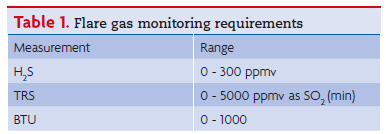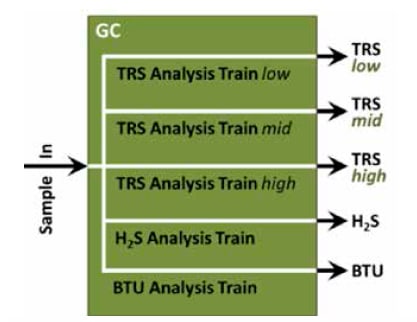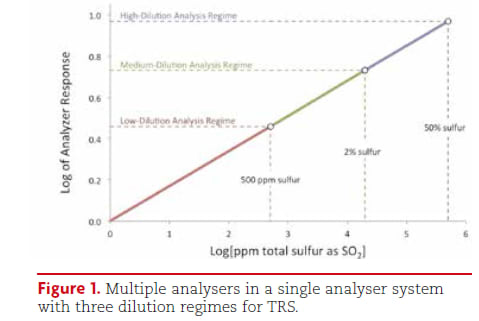Analyzing Sulfur Content in Flare Gas
High variability of volume and chemical composition of flare gas makes analysis for environmental regulatory compliance a challenge. Different technology combinations offer different capabilities.
Refiners routinely flare gas from the process that is not commercially recoverable. The amount of gas and its chemical composition changes according to operating conditions, but it's primarily methane with a few other products, including sulfur compounds. Steam may be added to reduce visible black smoke from the stack. Operation of a flare stack is typically regulated by local environmental authorities, and refineries may face limits as to the total volume burned along with requirements to monitor the level of sulfur content. If unreduced sulfur is included, it may also have to verify that the waste gas has sufficient BTU content to ensure full combustion of all components and sulfur reduction.
Generally, the two main components that regulators want to monitor are hydrogen sulfide (H2S) and total reduced sulfur (TRS).
The challenge for refineries is demonstrating compliance with the test methods, procedures and performance specifications cited in relevant regulations. Meeting those can present a variety of technical and economic challenges relating to the variability of flare gas at any given time. For example, measuring the concentration of TRS may span four orders of magnitude. Finding a device that can measure accurately across so wide a range while still meeting requirements of the rule for calibration and validation can be a major technical challenge and may require more than one device. The economic challenge is finding an approach that can do it all reliably, cost-effectively, and in conformity with the requirements of relevant specifications.
This discussion will look at various analyzer technologies and consider the approaches that are currently available with a critique of their underlying assumptions and effectiveness. The applicability of any one will have to be evaluated for your specific situation.
Complying with regulations
The U.S. EPA regulates flare gas under Title 40 CFR Part 60 Subpart Ja, which will be mentioned throughout this discussion, but there are parallel regulations in other jurisdictions to varying degrees. Subpart Ja regulations can be summarized in Table 1. (Strictly speaking, BTU content is not defined in Subpart Ja, but it is included elsewhere in Part 60.)
We will consider three main options available for achieving these measurements, but regardless of the approach, the regulatory environment in which refiners find themselves in any part of the world might leave them with technical solutions that are inadequate to the task at hand. Refiners often find themselves in a gap between compliance requirements and the limitations of available technologies.
One issue already mentioned is that the TRS level can vary enormously leaving the analyzer trying to monitor across a concentration range that may far exceed its dynamic range. Some analyzer manufacturers compensate by using internal techniques that extend dynamic range by means that change the sample (through dilution), the function of the analyzer (electronics, detectors, etc.), or both. Such changes effectively create multiple analysis systems (or analyzer regimes), which all have to be validated during routine span checks.
Can gas chromatography do it all?
Because gas chromatographs (GCs) are highly configurable, the possibility exists to integrate all three measurements within a single analyzer package. This sounds like a useful approach but the reality is more complicated. That single GC has to be configured with three separate channels or analysis trains, each with a dedicated injector, column, detector and oven to perform the measurements defined in Table 1. The result is that it is not a single analyzer, but is instead three discrete analyzers integrated into a common enclosure and controlled by a common processor.
Achieving a dynamic range that's three to five orders of magnitude, as may be required to measure TRS, could depend on a dilution scheme that roughly requires one dilution regime per 10- to 100-fold change in concentration. Consider a GC configured with three different dilution regimes to span TRS concentration in three ranges: low range up to a perhaps 500 ppm; the mid-range up to a couple percent; and high range up to perhaps 50%. When combined with analytical trains that also measure H2S and BTU, the so-called single analyzer that is really a 3-in-1 analyzer becomes a 5-in-1 proposition.
While a 3-in-1 chromatograph is conceptually appealing, the fact that it is three analyzers demands the individual calibration and validation of each analysis train, as would be the case for any trio of analyzers. Depending on the prevailing regulations, that could mean daily zero/span tests of all three.
To complicate matters further, analyzers that depend on dilution schemes rely on hardware that changes the sample by combining it with a diluent. Both the sample gas and diluent have to be metered individually using equipment that typically does not perform consistently across all stream compositions. For example, use of a mass flow controller assumes that the number of grams of gas per liter of sample is constant, which clearly is not the case. An alternative approach that meters a sample for dilution by constant-volume volumetric displacement is also problematic, as the dilution ratio varies according to the relationship P1 • T1 = P2 • T2, which demands temperature control to ensure reproducible dilution.
Beyond these problems, using a GC to measure TRS may present other associated issues. Coking may occur in the flame ionization detector (FID) used to oxidize compounds containing sulfur in reduced oxidation states.
All these factors suggest that working with three diverse applications is beyond the practical capability of one technology. The logical alternative is to consider the next option and assemble a multi-analyzer system based on technologies that are each optimized for their specific purpose.
GC with a dedicated TRS analyzer
Following the above logic, the measurement requirements defined in Table 1 are best met by a system that comprises analyzers best suited to perform the specific measurements: a gas chromatograph with two separate analysis trains to measure BTU and H2S combined with a total sulfur analyzer to measure TRS as SO2.
We'll keep the GC for BTU content and H2S. It is effectively the only technology available today that is suitable for the ranges we see in flare gas. Some have attempted to measure H2S spectrometrically, in particular by tunable diode laser (TDL) spectrometry, but background interference and dramatic variations in H2S line shapes may severely limit the accuracy of TDL for this application. If that were not the case, TDL certainly could be used to measure H2S, however, in the case where both BTU and H2S must be measured, the argument for introducing yet another technology simply to measure H2S is difficult to make on practical and financial grounds.
Similarly, although the spectrometric analysis of BTU content is possible in streams such as natural gas, this approach generally has difficulty in accurately differentiating between compounds heavier than butane, which in turn encumbers the accurate determination of fuel value.
Though gas chromatography is the default technology for analyzing BTU content and H2S in flare gas, one analyzer can't do both. There are actually two analyzers, each configured for a specific task. This suggests using the three-in-two analyzer option, pairing the two GCs with a total sulfur analyzer shown in Figure 2. A large number of refiners have adopted this approach after taking into account all technical, economic and regulatory considerations.
Wide-range TRS measurement
Refiners are well familiar with analyzers that verify sulfur levels in gasoline and diesel to meet regulatory specifications. Typically, these analyzers rely on ultraviolet fluorescence (UVF), which selectively quantifies sulfur on the basis of electrons excited by UV radiation. Though suitable for single-range measurement of sulfur in motor fuels at levels below 50 ppm, application of these technologies to measure TRS up to percent levels in flare gas suffers the same limitation as GCs discussed earlier. Dilution schemes must be implemented because the core sensor technology lacks the dynamic range necessary to measure TRS across the nearly three orders of magnitude required for the 0 – 5000 ppmv minimum range, much less that required to make measurements at percentage levels. The implications of dilution for TRS analysis are as much of a problem for conventional sulfur analyzers as they are for TRS analysis by gas chromatography.
There is a new EUVF technology for TRS measurement that does not require dilution schemes and associated questions. The solution still uses a process GC to measure BTU content and H2S, but it is paired with new EUVF analyzer technology, designated as the EF.60107, for measuring TRS. This type of analyzer is now installed and operating at a major U.S. refinery. It can measure TRS across four orders of magnitude, from 100 ppmv to 1,000,000 ppmv (100%), without the need to dilute the sample. Therefore, the solution incorporates three analytical trains – not four or five – because it requires no dilution to span the full range of possible TRS concentrations.
Figure 4 presents results for analysis of H2S for TRS using this new approach. With a measurement interval of only 100 seconds, the results (blue) appear to be nearly continuous, whereas the conventional GC results (maroon) exhibit stair-step characteristics due to its 10-minute analysis cycle time, characteristic of most GCs. Note that essentially all of the sulfur in the flare gas stream was in the form of H2S, necessitating for purposes of clarity the offset of the results from the new approach relative to those from the conventional GC.
Even before making a rigorous statistical comparison between the two sets of results, Figure 4 permits important qualitative assessments. First, the new device's response to actual changes in stream composition appears to be nearly instantaneous, when compared with the GC results.
Second, the higher amplitudes of the periodic oscillations and the sharpness of the associated peaks gives further evidence that the EUVF-based technology does not suffer from dilution or sample carryover effects between measurements. Instead, each 100-second interval measurement represents the result for a discrete sample. Equally important, Figure 4 shows that it tracks the GC in revealing the broad contours of process variation.
Third, due to the limited variation of total sulfur in the process stream, the data set does not reveal the full dynamic range and linear response of the new approach. Using a factory calibration based on 100% H2S, the agreement of the new EUVF analyzer with a certified standard containing 5882 ppm H2S was within a difference less than ±0.1%, relative. Results shown in Figures 4 and 5 were obtained after a zero/span calibration with that gas to obtain the following calibration equation:
ppm H2S = 0.999185 x REUVF + 30.89
where REUVF = reading of the EUVF analyzer based on the original factory calibration.
This approach produces results at a rate that is six-times higher than the conventional GC (one result every 100 seconds versus one result every 10 minutes or 600 seconds). Figure 4 shows almost 1000 results from the EF.60107 compared with only 164 from the GC over a defined time period.
To reveal the relationship between results from the two analyzers in greater detail, Figure 5 shows only those results for the analyzer that correspond in time to the GC results. The data reduction in Figure 5, compared with Figure 4, suggests that the responsiveness of the new analyzer technology provides a more accurate accounting of total sulfur, evidenced by the fact that high values are higher and low values are lower, compared with results from the GC which result in averaging out these peaks.
The EUVF analyzer technology has a wider linear dynamic range of measurement than conventional technologies offered for TRS measurement. Analysis of total sulfur content is accomplished utilizing a single sample injection valve and single PMT (photomultiplier tube) power supply, allowing a single-point calibration for the intended measurement range. This not only simplifies calibration complexity and minimizes time offline during calibration, but also reduces costs associated with multiple calibration gases, regulators and gas switching components.
Analyzers utilizing one or more additional dilution regimes inject a sample whose size is different compared with the first. The possibility exists that some results will have diminished accuracy during the time required to reestablish analytical equilibrium, which may be equal to or greater than the analyzer response time.
By contrast, the EUVF analyzer produces a high-fidelity representation of peak profiles and peak concentrations, which are significantly more consistent than can be inferred from the GC data. Total sulfur analyzers that are generally considered fast claim response times of three to five minutes, which would still be too slow to capture an accurate picture of the peak concentration in this example.
Many conventional analyzer technologies must overcome limits to their measuring range through dilution and other engineered adjustments that effectively create analyzer regimes that regulators may not find acceptable. Compared with conventional approaches available until now, the dilution-free, three-for-three approach offers refiners distinctive benefits including improved performance, unambiguous fulfillment of regulatory requirements, and lower lifecycle costs.
Productos y Soluciones Relacionadas
-
Process Gas Chromatograph GC8000
The GC8000 has a built-in 12-inch color touchscreen display that dramatically simplifies operations. At the touch of the screen, the technician can access all of the analytical parameters and measurement results; displayed in easy-to-understand graphical color screens.
-
Gas Analyzers
- Gas analyzers
- Real-time gas analysis
- Enhances efficiency, safety, throughput, product quality
- Ensures environmental compliance
Have Questions?
Contact a Yokogawa Expert to learn how we can help you solve your challenges.




